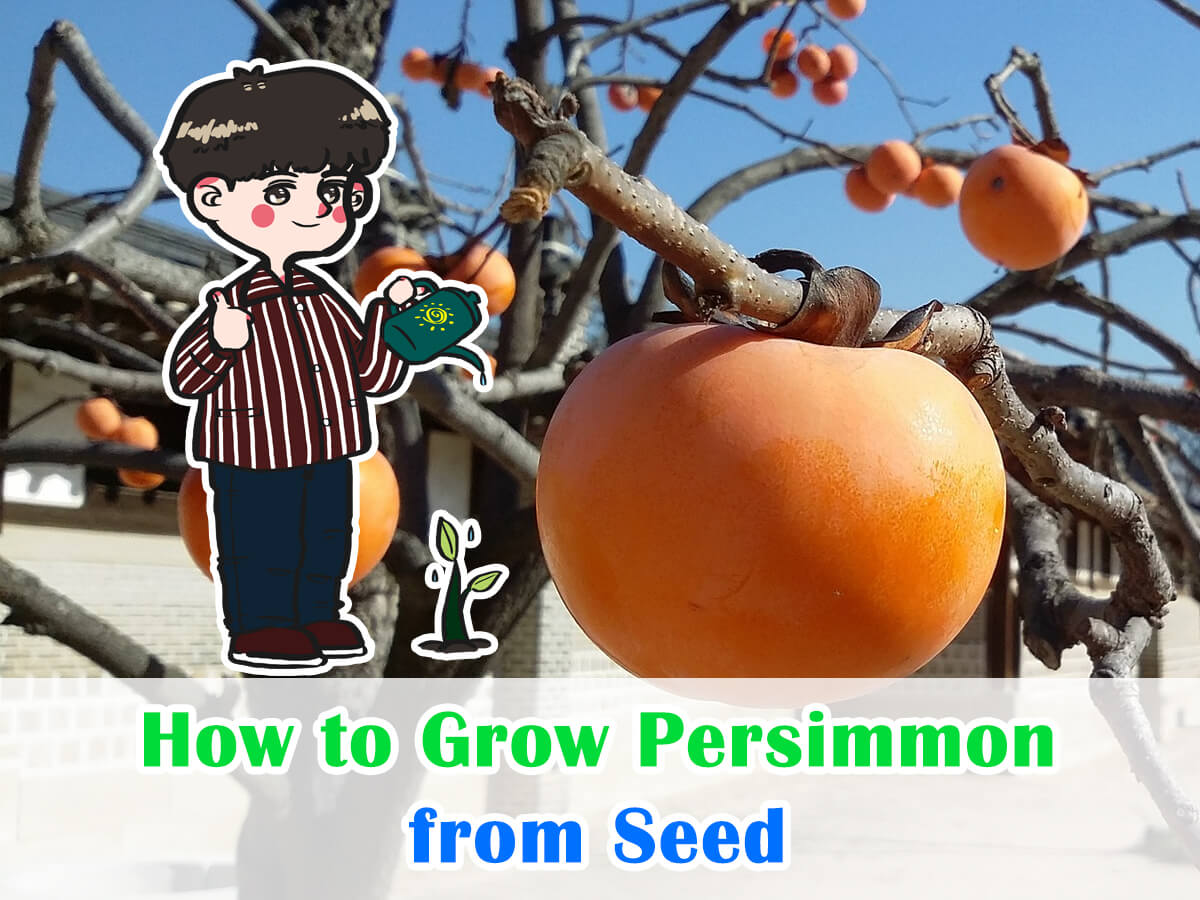Ah, the sweet persimmon. I remember the first time I tasted its rich, honey-like flavor, picked right from the tree in my grandmother’s backyard. I was hooked, and it’s been a favorite fruit of mine ever since.
It wasn’t until many years later that I attempted to grow my own persimmon tree from seed. I’ll admit, I was a bit skeptical at first – how could a mighty tree sprout from such a tiny seed? But with patience, care, and these simple steps, I found myself rewarded with a beautiful persimmon tree in my own backyard.
Today, I want to share with you the joy and satisfaction that comes from growing your very own persimmon tree from seed. So, whether you’re an experienced gardener looking to add a unique fruit tree to your collection, or a beginner hoping to grow something different, this guide is for you.
How to Grow Persimmon from Seed, Step by Step
1. Prepare Your Persimmon Seeds
Like any great endeavor, the process begins with a little preparation. In this case, we’re talking about preparing your persimmon seeds for planting. After enjoying a sweet, ripe persimmon, gently scoop out the seeds and rinse them under warm water. It’s important to remove any remaining fruit pulp, as it can inhibit germination.
Next, pat your seeds dry with a soft cloth or a paper towel. Then, put them inside a sealed container or ziplock bag filled with moistened peat moss or vermiculite. Why do we do this? Well, persimmon seeds require a process called stratification – a period of cold and moist conditions to mimic winter – to germinate. By storing them in the refrigerator for about three months, we’re giving them this simulated winter experience.
2. Sow Your Seeds
Once the seeds have undergone stratification, they’re ready to be planted. Fill a plant pot with a mixture of well-draining potting soil and perlite or sand – about 2 parts soil to 1 part perlite or sand will do the trick. Then, place your seed on top of the soil mix, and cover it with about 1 inch of soil. Make sure not to plant your seed too deep, as this can prevent it from germinating.
Having completed this process myself, I can’t recommend enough the convenience and quality of the Miracle-Gro Potting Mix, a highly rated item available on Amazon. Not only does this combination provide a balanced, nutrient-rich environment for the persimmon seeds, but the addition of perlite ensures excellent drainage, reducing the risk of overwatering and root rot.
Water the newly planted seed thoroughly, but be careful not to overwater. You want to ensure the soil is moist, but not soggy. Soggy soil can lead to seed rot. Place the pot in a sunny spot where it can get at least 6 hours of sunlight each day.
3. Nurture the Sprouting Seedling
After some weeks, you’ll witness a fascinating sight: the first sprout pushing its way out of the soil. Congratulations! You’ve successfully germinated your persimmon seed. The work doesn’t stop here, though. Young seedlings are quite delicate and need careful attention during this early stage of growth.
Ensure your seedling continues to receive ample sunlight and water, and keep an eye out for any signs of disease or pests. One common problem is damping-off, a disease that causes seedlings to suddenly wilt and die. To prevent this, ensure your seedling has good air circulation and avoid overwatering.
4. Transplant Your Tree
Once your persimmon seedling has grown a few inches tall and has at least four leaves, it’s ready to be transplanted. Gently remove the plant from its pot, being careful not to damage the root system. Choose a sunny location in your yard where the tree will have plenty of room to grow. Persimmon trees can get quite large, so keep this in mind when choosing a spot.
Dig a hole twice as wide and deep as the root system of your seedling. Place your persimmon tree in the hole, ensuring that the top of the root ball is level with the ground. Backfill the hole with soil, and tamp it down lightly to remove any air pockets.
Then, give your newly transplanted persimmon tree a good drink of water. Remember, it’s better to water deeply and less frequently than to water a little bit every day. The goal is to encourage the roots to grow deep into the soil. Mulching around the base of the tree can also help retain moisture and keep weeds at bay.
5. Care for Your Growing Tree
Now that your persimmon tree is in the ground, the real adventure begins. As your tree grows, it will need continued care to thrive. One thing I learned along my journey of growing a persimmon tree is that they are quite resilient once established, but it’s still crucial to monitor their growth.
Water your tree regularly, particularly during dry periods. Prune your tree in late winter or early spring to maintain its shape and remove any dead or diseased branches. Also, apply a balanced, slow-release fertilizer in the spring to provide necessary nutrients for your tree.
Keep an eye out for pests and diseases. Persimmons are relatively disease-resistant, but like any plant, they can be prone to certain problems. If you notice anything amiss, take action promptly to address it. See the troubleshooting section below for more information.
In addtion, here is a great video by The Millennial Gardener that demonstrates persimmon tree pruning:
6. Be Patient and Reap the Fruits of Your Labor
Finally, after a few years of caring for your persimmon tree, you’ll start to see fruits. It’s a moment of great satisfaction and anticipation! But remember, persimmons take a while to ripen. Don’t be tempted to pick them too early; unripe persimmons can be extremely astringent. The fruit should be fully colored and slightly soft to the touch when it’s ripe and ready to eat.
Seeing your persimmon tree laden with fruit is an incredibly rewarding sight, a testament to the time, effort, and love you’ve put into nurturing it from a tiny seed.
Troubleshooting Common Persimmon Growing Problems
1. Overwatering
Overwatering is a common mistake, especially among new gardeners. Persimmons, like most fruit trees, prefer deep, infrequent watering to shallow, frequent watering. Overwatering can lead to root rot, a serious condition that can cause your tree to wilt and potentially die.
How to fix it: Always check the soil before watering. If the top few inches are still moist, hold off on watering. If you’ve been overwatering, allow the soil to dry out before the next watering. Remember, it’s better to under-water than overwater.
2. Pests
Persimmon trees can attract various pests, including mealybugs, scale insects, and mites, each presenting its own set of challenges:
- Mealybugs are small, white, cottony insects that cluster in protected areas of the tree and feed on the plant’s juices, potentially leading to yellowing and curling of leaves.
- Scale insects, appearing as tiny bumps on leaves and stems, are sap-sucking pests that can cause leaves to wilt or discolor.
- Mites, although minute and often unnoticed until damage appears, can also feed on your persimmon tree, leading to speckled, bronzed, or distorted foliage.
These tiny critters, if not dealt with promptly, can cause significant damage to your tree, including leaf drop, decreased vigor, or in severe cases, death of the tree.
How to fix it: Regularly inspect your tree for any signs of pests. If you notice a pest infestation, you can often treat it with a mild insecticidal soap or horticultural oil. In severe cases, you may need to use a more potent, yet fruit-friendly pesticide. I personally use Bonide Captain Jack’s Deadbug Brew Flower & Vegetable Garden Dust. It’s completely organic, and it effectively deals with all types of harmful insects. The Garden Dust is safe to use on any fruit tree, including persimmon. It’s also quite affordable and have over 450 positive reviews on Amazon.
3. Diseases
While persimmons are generally disease-resistant, they can still be susceptible to certain diseases, like leaf spot and anthracnose. These diseases can cause unsightly spots on the leaves and, in severe cases, can lead to leaf drop.
How to fix it: To prevent diseases, ensure your tree has good air circulation and avoid getting the leaves wet when watering. If your tree is infected, you can usually control the disease by pruning away the affected areas and applying a fungicide.
4. Lack of Fruit
One common issue that many gardeners encounter is a lack of fruit production. This can be particularly frustrating after putting in so much effort to grow your tree.
How to fix it: Lack of fruit can be caused by a number of issues, such as inadequate pollination, poor nutrition, or environmental stress. To address this, consider planting another persimmon tree nearby to aid in pollination. You might also want to test your soil to ensure it has the necessary nutrients for fruit production. If environmental stress is the issue, such as a late frost, there might be little you can do but wait for next year.
Exploring Persimmon Varieties
Now that you know how to grow persimmon from a seed, I want to take a moment to encourage you to explore the fascinating world of persimmon varieties. There’s a whole spectrum of flavors, textures, and shapes awaiting you in the persimmon family. Here are a few of the most popular varieties:
- Fuyu Persimmons: This is one of the most widely grown and eaten varieties. It’s a non-astringent variety, meaning it can be eaten while still hard. Fuyu persimmons have a rounded, slightly flattened shape and are often compared to tomatoes in terms of appearance. They have a sweet, mildly spicy flavor and a crunchy texture when eaten fresh.
- Hachiya Persimmons: Unlike Fuyu, Hachiya persimmons are astringent and must be fully ripe before eating. When ripe, they become incredibly sweet and have a jelly-like texture. They’re heart-shaped and larger than Fuyu persimmons.
- American Persimmons (Diospyros virginiana): This is a native species of the eastern United States. Its fruits are smaller compared to the Fuyu and Hachiya varieties and become sweet and flavorful once fully ripe.
- Saijo Persimmons: Saijo persimmons are known for their elongated, oblong shape and are considered one of the sweetest astringent varieties. They’re best when fully ripened.
- Chocolate Persimmons: Also known as the Black Persimmon, this variety has a unique, sweet flavor that hints of chocolate, hence the name. It also features dark streaks through the flesh when fully ripe.
These are just a few examples of the many persimmon varieties out there. Each one has its unique flavor profile and growing requirements. Depending on your taste preference and climate, you may choose to grow one or several of these delightful fruits.
In Conclusion
Growing a persimmon tree from seed can be a long journey, but the experience is well worth it. You learn a lot along the way, not just about the persimmons themselves, but about patience, care, and the rewarding process of nurturing something from a tiny beginning to a magnificent result.
So, if you’ve ever considered growing your own persimmon tree, I hope this guide has inspired you to give it a try. You might just find that you have a green thumb, too. Enjoy growing plants from their seeds!
Happy gardening!



